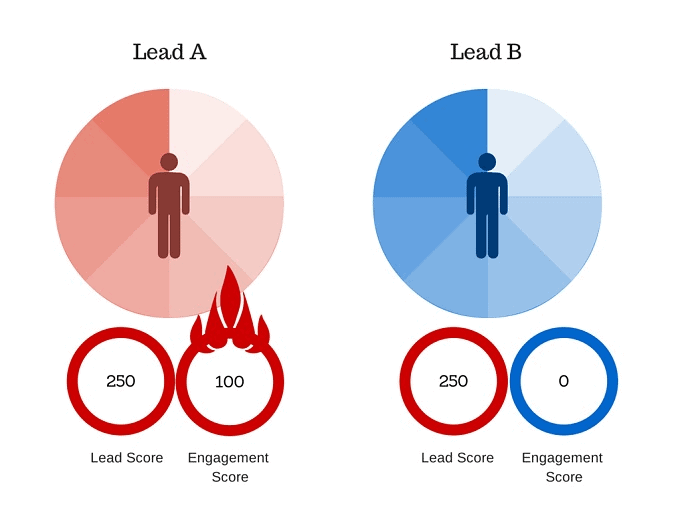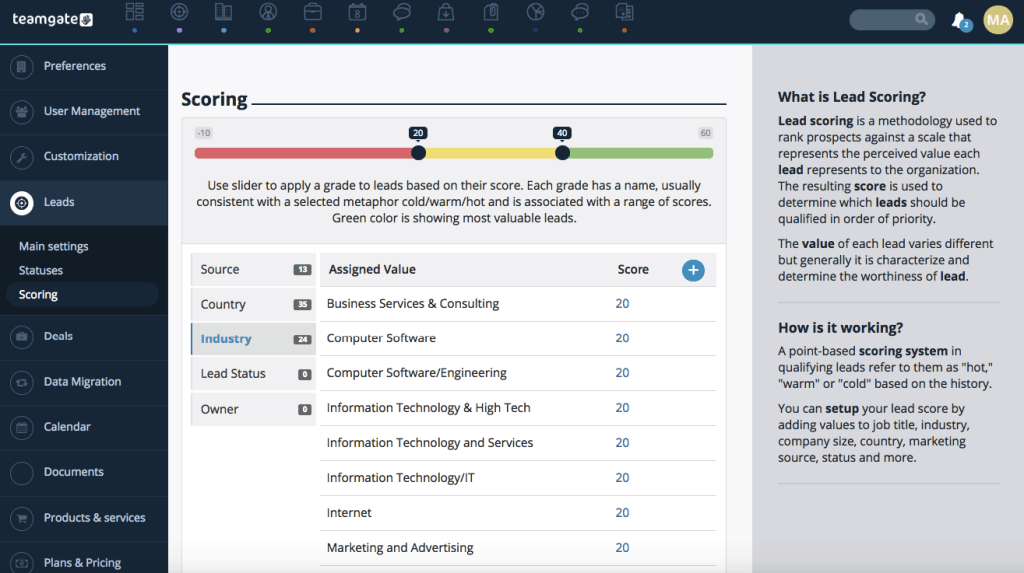

If you start with inbound marketing, you initially think about how to generate as many leads as possible. However, once a certain quantity has been reached, the focus is on the quality of the points achieved – and thus inevitably the lead scoring method.
What is Lead Scoring?
Simply put, lead scoring is the most numerical assessment of leads that have already been generated. The focus is on all data previously transmitted by the lead contacts as well as the classification of the points into different parameters. Likewise, the operational processes that make leads on your site are considered in the evaluation. Thanks to lead scoring, leads can be prioritized. To increase the sales conversion rate, this, in turn, helps the marketing and sales departments react constructively to points.
Learn more about the concept of lead scoring in the following video:
There is no single model for scoring leads. However, a common practice is first to analyze which of the previous contacts have already become customers and which are not. Also, you evaluate the previously known information about the person and the past interactions with your content. This enables you to quickly identify which lead fits your product or service offering or your business model – and which does not.
Individual lead scoring models
Based on the data collected, you can create your points system and thus your lead scoring model that defines the characteristics of your target audience. Here are a few lead scoring models based on the classification of collected data from users who are already involved with your business:
1. Demographic information
First, think about which audience you want to target, and use replies to demographic queries to see how well a lead matches your intended goal. The better a contact matches your needs, the more points you award to the edge. Leads that correspond less or not at all to your target audience will be allocated fewer points accordingly. Remember that individual leads do not fit into your target category at all, you have the opportunity to note negative assessments. On the other hand, you award additional points if interested parties provide data that was only optionally requested. Because it shows an increased interest in your content.
2. Company data
You may have targeted your B2B business model to name companies that you primarily or exclusively want to address. In terms of your rating system, ask the industry of your contacts or the size of the company. In turn, you can differentiate the relevance of your leads accordingly.
3. Online Engagement
Include the online interactions of your points in the scoring. Take into account the number of page views, which pages the users viewed, as well as which and how many offers were downloaded. Check all these surveys at regular intervals and adjust your ratings always to have an up-to-date picture of your leads.
4. Email behavior
Opening and CTR of points who sign up for your email also say a lot about the interest of the contact in your business. Lead scoring also tells you how committed Leads is to your mailings – and how relevant each lead is to your sales team.
5. Social media engagement
The interest of a point in your offer can also be recognized by how committed it is to your social media offerings. So check to see if edges are sharing your content and how they’ve engaged with your tweets and Facebook posts.
6. Spam detection
Do give not only points for positive aspects but also negative reviews, for example, if you have a reasonable suspicion that these are spam contacts. Using filled-in form fields, fakes can be identified primarily by B2B communications, for instance, in bad grammar or by entering the traditional “QWERT” keywords. You can also identify spam by using given email addresses, for example, when alleged companies use simple Google Mail or Yahoo! email addresses. In these cases, you simply deduct evaluation points from the lead.
Relevant data for a lead scoring model

Combine data for your lead scoring model with information from your sales team, your own analysis, as well as data from customer surveys. This gives you comprehensive parameters that are valuable to you when converting leads to customers.
Feedback from the sales force brings valuable insights from employees who are direct with the customer or even with interested parties to the increase in the conversion rate and in an intensive, mostly personal mutual communication.
Even the hard data of your marketing analytics play a significant role in creating the lead scoring model. Find out which marketing measures lead to changes in the entire Funnel. Award points for downloaded content that converted contacts to leads, and more locations to users who download content that experience converts converted contacts into customers.
Finally, talk to your customers to take into account opinions that may differ from those of your sales force. Take into account both customers who have been involved in short as well as long sales cycles. Perform also customer interviews to find out what was decisive in their buying decision.
Do you need more than just a lead score?

If you value regular customers, a single model is enough for the load rating. But if your business expands, you may need to focus on developing product lines, new personas, or additional regions. Your rating system should always reflect the divergence of your contacts.
With inbound marketing software like HubSpot, you can also create multiple lead scoring systems. This gives you the flexibility to qualify different contact groups in different ways.
For example, you can create different lead scores for different product lines that are sold to different types of customers through differentiated sales teams. Your lead scores then you cut to the respective buyer’s version and the specific interest in each tool. The results are critical to deciding, which leads to passing to the right sales teams.
Also, differentiate customers from their interoperability (such as the right industry) and their level of interest (such as the engagement shown in dealing with your online content). If both options are a priority, you can create both an Engagement and a Fit score, so you can prioritize the reach of high-value contacts in both categories.
Always keep in mind that the parameters for new entrants often look entirely different than for existing customers. As your business grows, you can focus on up-selling or cross-selling as well as on new business. While existing customers need to analyze the number of customer support tickets submitted, engagement with an onboarding consultant, and current activity with your products, you can first focus on demographic trends and engagement on your site with potential new customers.
If these buying parameters look different for different types of sales, be sure to consider creating multiple lead scores.
The lead scoring value

There are many different ways to calculate a lead scoring value. We introduce three possible ways:
1. Manual lead scoring
Your lead-to-customer conversion rate is the number of new customers you win, divided by the number of leads you generate. Use this conversion rate as a benchmark. Based on the conversations you have had with your sales team, analysts, etc., choose different attributes, and select customers that you believe are high-quality leads. You can quickly develop five different Personas or five different models – as long as your rating is based on the data as mentioned above.
Calculate the individual completion rates of different attributes. To find out which reactions you should react to and how many users will turn your actions into qualified leads (and ultimately, customers).
Compare the completion rates of individual contacts with your overall rates and assign the points accordingly. Pay attention to the standards of personal communications, which are significantly higher than your overall speed. Then select which contacts you want to assign how many points and try to be as consistent as possible with the scores.
2. Logistic regression lead scoring
With data mining techniques, the systematic use of computer-aided methods to detect patterns, trends, or relationships in existing data sets. Excel creates a formula that tells you if a lead is close to a customer. It is a holistic approach that takes into account all customer attributes, such as industry, company size, or whether someone has requested a study or not.
3. Predictive Lead Scoring
Creating a lead score can have a significant impact on your business: optimizing the lead handoff process, increasing the lead conversion rate, improving rep productivity, and more. However, with a manual implementation, the development of a rating system can be very time-consuming.
When you get feedback from your team and test the results, you need to optimize your lead scoring system to stay up-to-date regularly. That’s why it’s imperative that the technology handle manual setup and continuous optimization, leaving more time for your team to build relationships with your customers. Here’s where we come to the importance of predictive assessment. Predictive Lead Scoring uses machine learning to analyze thousands of data points and identify your best leads. The system scans which parameters your customers have in stock and which do not. In turn, Predictive Lead Scoring develops a formula that sorts your contacts by relevance based on their potential for customer transformation. So you can prioritize leads,
As with any machine learning application, your predictive score will continually become smarter over time, so your lead-follow-up strategy will be self-optimizing.
Conclusion
Careful use of lead scoring helps to classify leads better and classify them more effectively. The marketing is shown whether or when a point is qualified enough for the transfer to the sales department. Supplying sales with high-quality leads is increasing, and the entire process of acquiring new customers is becoming more efficient and effective.
